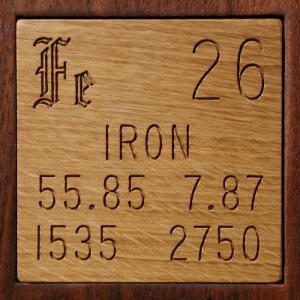Thermite steel.
Thermite is amazing stuff: Take some magnetite sand, which you can collect from many beaches by dragging a magnet through the sand (I got mine on Ocean Beach in San Francisco, thanks to a magnet from the helpful folks at the Exploratorium), and some aluminum powder which you can buy in a very well-stocked paint or artists supply store, and you can mix up a powder that, when lit, burns hotter than almost any other chemical reaction and produces as its end product white-hot molten steel (see chain link sample below for a video of this reaction). Great fun, and insanely dangerous if anything does not go according to plan.
Done properly, thermite burns vigorously but not explosively, and you can controllably create a mass of molten steel falling out the bottom of a ceramic cone. This steel can be used to make castings or to weld large pieces of existing steel. For example, high-speed train track is commonly welded using the thermite process, which allows two sections of rail to be joined into a single piece, leaving no visible weld or weak spot in the track. Welding the conventional way could not join the rails as completely, but thermite steel is so hot it is able to fuse the sections completely.
To get the steel to fall out the bottom of the crucible at the right moment, you plug a hole in the bottom with a disk of material designed to melt through when the hot iron reaches it. My first large batch, about a pound, burned great for about 3 seconds and then exploded, which is not something thermite is supposed to do. It turns out I should not have used a zinc penny to cover the hole in the bottom of the crucible: The boiling point of zinc is much less than the temperature reached by the reaction, so when the molten iron hit the penny, it exploded into zinc vapor. A copper penny was only slightly less explosive: Turns out you're supposed to use an aluminum disk. Using folded up layers of aluminum foil I have had no more problems with explosions. Which is not to say I'm anywhere closer than 20 feet away whenever I ignite thermite: It would be really quite stupid not to take into account that at any moment, there could be blobs of white hot steel flying in all directions at a rapid rate of travel.
Thermite is a mixture of iron oxide and aluminum. When it is set off, the aluminum rips the oxygen away from the iron oxide, forming aluminum oxide and iron metal. This releases a lot of heat because aluminum binds oxygen much more tightly than iron. (Which is reflected in the fact that we learned how to reduce iron oxide to iron metal thousands of years before we learned how to reduce aluminum oxide to aluminum metal.)
There are actually several different kinds of iron oxide, Fe2O3 (red rust), and Fe3O4 (magnetite) being the most common. Thermite can be made with either: Magnetite thermite is said to burn hotter than red rust thermite, but both work. The fun thing about magnetite is that you can find it lying around any beaches in many parts of the country. I collected about 40 pounds on Ocean Beach in San Francisco, in less than half an hour using a large magnet.
Source: Theodore Gray
Contributor: Theodore Gray
Acquired: 13 July, 2003
Price: Donated
Size: 0.75"
Purity: >90%
|
| 
|
|